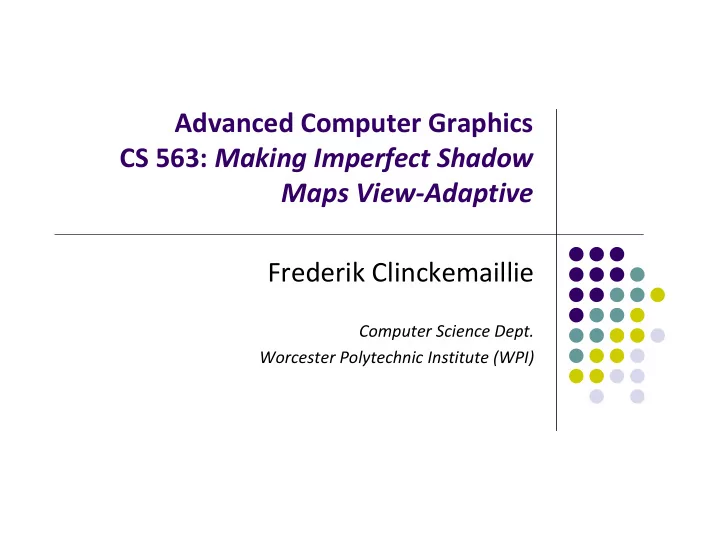

Advanced Computer Graphics CS 563: Making Imperfect Shadow Maps View ‐ Adaptive Frederik Clinckemaillie Computer Science Dept. Worcester Polytechnic Institute (WPI)
Background: Virtual Point Lights Simulates indirect illumination by creating VPL Evaluates shading combining illumination from all VPLs Costly with large scenes
Background: Reflective Shadow Maps Renders the scene from the light’s point of view Used to generate VPLs efficiently Uses different methods to determine which points should become VPLs Randomly Based on Outgoing Irradiance
Background: Imperfect Shadow Maps Computed to resolve visibility Preprocess image to reduce it to points instead of triangles Points are then added to ISMs if visible Pull ‐ Push Interpolation is used to fill in holes.
Problem Method does not scale well with large scenes Will require many VPLs for acceptable LOD VPL distribution does not consider contributions on the final image Large scene may cause point ‐ based representation (for ISM) to be too coarse.
Previous Work Reusable VPLs[Laine & Al.] Cannot handle dynamic scenes Ray ‐ tracing Bidirectional Importance Sampling [Segovia & Al.] Too slow to manage large and dynamic scenes Importance of nearby visibility events [Arikan & Al.] Used coarse approximation to improve performance
Proposed Solution Use different VPL distributions to provide more detail in areas of high importance Adapt the scene representation for indirect visibility to ensure geometric detail
Proposed Solution (cont.)
Bidirectional Reflective Shadow Maps Performs Bidirectional Importance Sampling without the use of ray tracing Scene is rasterized from : Current view into a frame buffer Point of view of the light into a reflective shadow map RSM texels represent potential VPLs (pVPL) from which VPLs have to be selected
Bidirectional Reflective Shadow Map
Selecting VPLs from pVPLs Selection Distributions: Uniform May require large amount of samples Based on outgoing irradiance Performs better than uniform VPL might not illuminate any view sample Based on the influence of each pVPL on all view samples Optimal, but too costly Requires normalization to avoid bias Simplifications can be made for approximation
Selecting VPLs from pVPLs (cont.) Simplifications used: A pVPL evaluates its impact on a few randomly ‐ chosen view samples In practice about 0.1% percent Visibility is neglected when evaluating contributions from each pVPL Removes the need for ray ‐ scene intersections Only light and view sample position are required pVPL contributions are stored in Bidirectional Reflective Shadow Map (BRSM)
Technical Details Constructing the BRSM Starts with a regular grid, but jitters lookup position Each pVPL uses random value texture to create unique pattern
Technical Details (cont.) Choosing VPLs Uses several cumulative density functions (CDF) Derive a CDF for each column C y [ i ] of the BRSM Compute CDF C x from the sums of values in each columns For uniform sample: [x, y] T ∈ [1, . . . ,width] × [1, . . . ,height] Column Position i := C − 1 x [x] Row Position j := C y [i] − 1 [y] Samples divided by probability by which it was chosen
Results Comparison
Improving View ‐ Sample Selection for BRSM So far, view samples are random Improvement: Selecting view samples that pVPL impacts strongly Cannot involve information about view sample Depends on rendering equation: All terms depend on view sample values
Improving View ‐ Sample Selection for BRSM Simplifying Approximation Use the pixel position in frame buffer Pixels close in real space will be close in frame buffer Use distance falloff of 1/x 2 Performs well in challenging situations Corners will have many VPLs to avoid singularities Allows for reduction of light blotches clamping
Improving View ‐ Sample Selection for BRSM
Adaptive Imperfect Shadow Maps Handles visibility in larger scenes than with ISM Blocker sampling is variable Denser for closer geometries Coarser for farther geometries
Adaptive Imperfect Shadow Maps Finding a point ‐ based blocker representation Ideally, consider all triangles and view samples Efficient approximation: Solid angles of all triangles are calculated CDF is created based on solid angles CDF is used to obtain N triangles Random points in the triangles are determined Using Barycentric coordinates
Sample ‐ based Adaptivity
Using Barycentric Coordinates [courtesy of hairrendering.wordpress.com]
Making the Algorithm Run ‐ Time Computing all triangle’s blocking for all view samples is too slow Instead, randomly choose a set of view samples per triangle Eight view samples per triangle Increasing number with area not necessary
Dealing with Dynamism High level of detail can damage temporal stability Lazy update scheme Not all scene points are updated each frame Performs better than uniform sampling Human observer perceives fewer detail in motion Speeds up algorithm In practice, 1/8 th of all points are updated each scene
Results Run on Nvidia GTX 480 at 1600 x 800 Interactive performance (around 15 fps) Algorithm adds 14ms GPU overhead for ISM
Results Bidirectional instant radiosity Does not depend on ray ‐ tracing, making it real ‐ time Limitations Lazy adaptation improves temporal incoherence, but adds lag. Rasterized images are discrete, which could cause loss of information smaller than a pixel. Approach is not independent of scene size
Results
Results
References T. Ritschel, E. Eisemann, I. Han, J. D. K Kim, H. ‐ P. Seidel Making Imperfect Shadow Maps View ‐ Adaptive: High ‐ Quality Global Illumination in Large Dynamic Scenes in Proceedings Eurographics Symposium on Rendering 2011
Recommend
More recommend